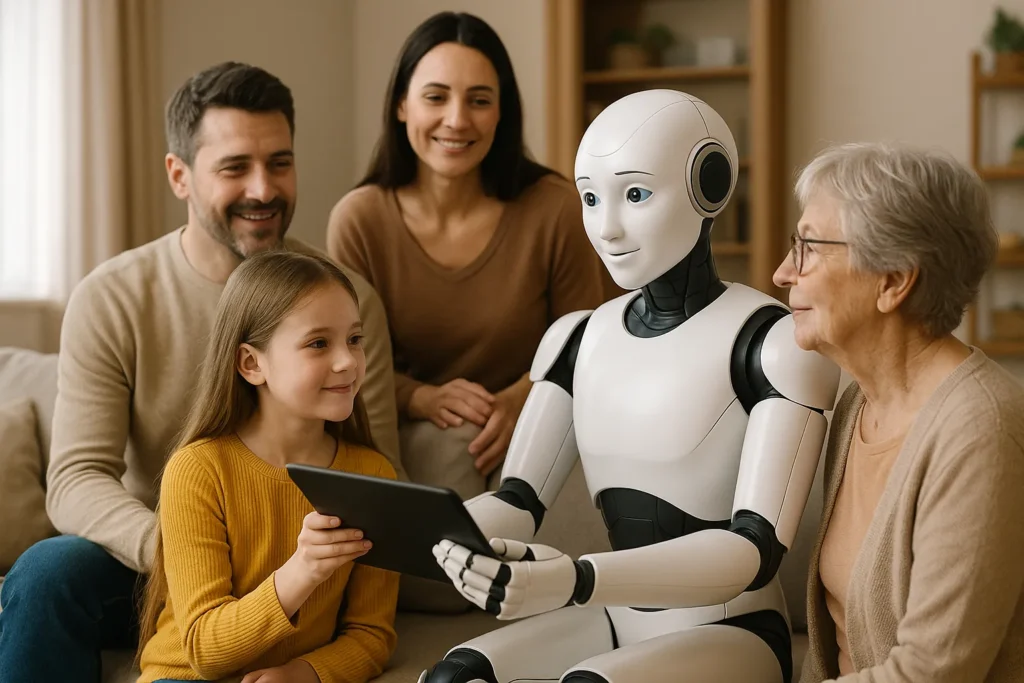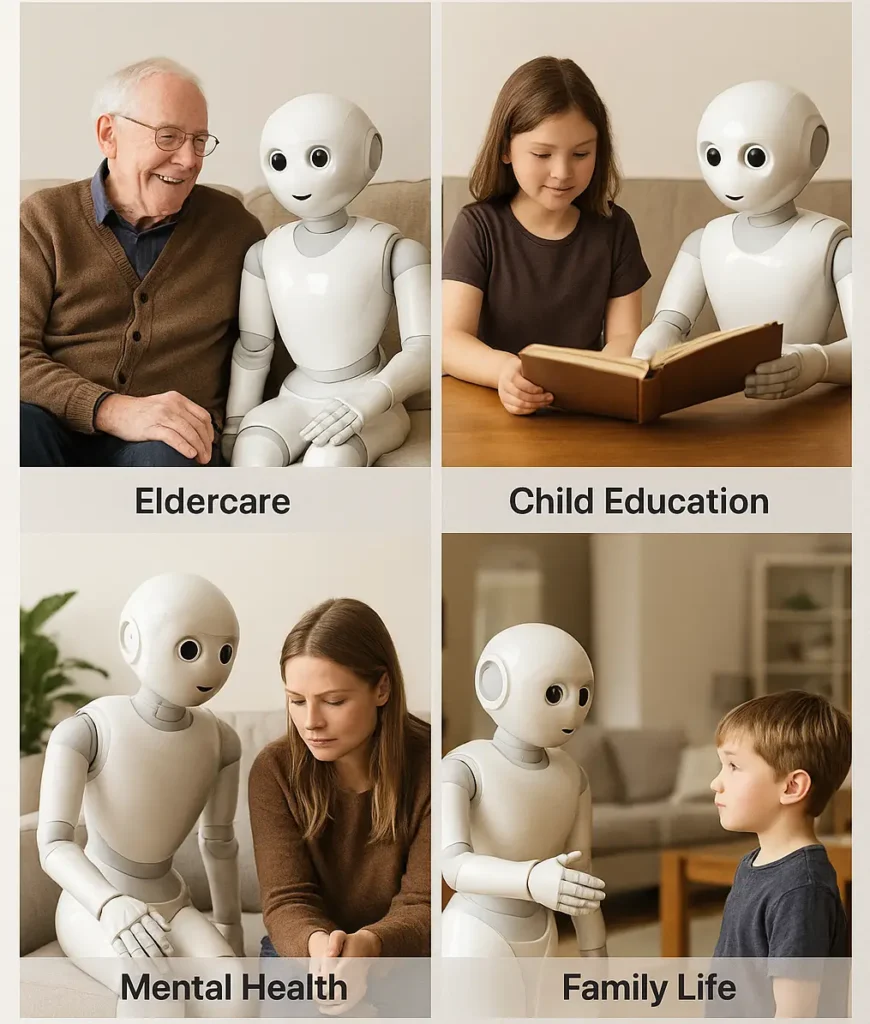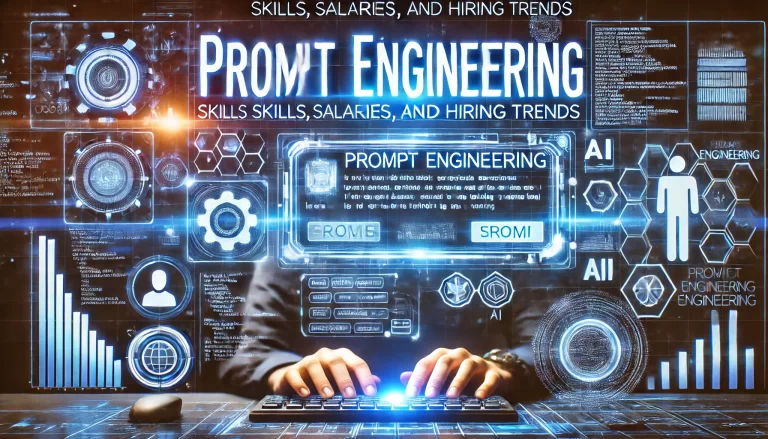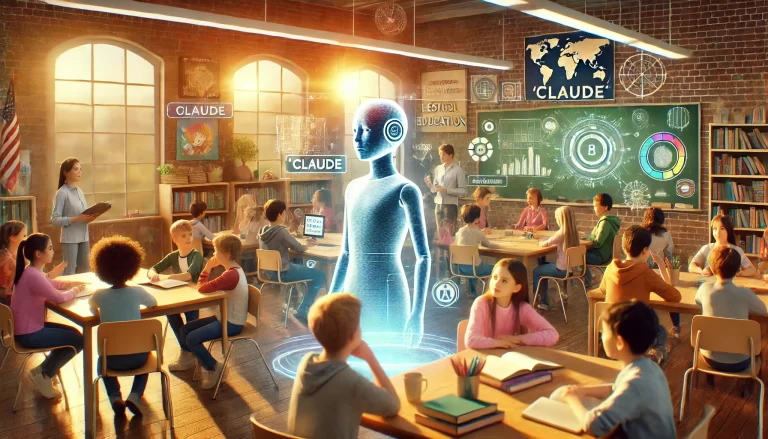The 1 Family, 1 Robot Era: Emotionally Intelligent Humanoid Robots Are Coming Home
Emotionally intelligent humanoid robots are no longer a futuristic fantasy—they are becoming a part of daily life in homes around the world. These machines don’t just respond to commands; they perceive, interpret, and react to human emotions. From recognizing frustration in a child’s voice to comforting an elderly person who lives alone, their purpose is shifting from functionality to emotional presence. The boundary between technology and empathy is dissolving—quietly, and powerfully.
This transformation marks the beginning of the “1 Family, 1 Robot Era”, where every household may soon count a humanoid robot among its members. Enabled by breakthroughs in generative AI, affective computing, and robotics engineering, these robots are designed to act with emotional sensitivity. They read facial expressions, adapt their tone, and build rapport—not unlike a family member. As emotional AI becomes more reliable, families are beginning to view robots not as cold machines but as responsive companions.
In this blog, we’ll explore how emotionally intelligent humanoid robots are entering homes, why this shift is happening now, and what it means for the way we live, connect, and care. From caregiving and education to companionship and ethics, this is the beginning of a new kind of relationship—between humans and machines that feel.

1. What the Future Holds: Will Every Family Have an Emotionally Intelligent Robot by 2035?
The trajectory is clear: emotionally intelligent humanoid robots are moving from novelty to necessity. As costs decline, capabilities expand, and public comfort grows, it’s not far-fetched to imagine a near future where having a robot at home is as normal as having a smartphone.
📈 Market Momentum and Investment
According to recent forecasts by McKinsey and ABI Research, the global market for emotionally responsive consumer robots is expected to exceed $30 billion by 2030, driven by demand in eldercare, child education, and emotional wellness. Major players like Amazon, Tesla, and Samsung are already investing heavily in home robot development, while startups like Figure AI and Embodied are leading the way in emotional AI specialization.
🌍 A Global Race Toward Domestic Integration
Countries with aging populations—Japan, South Korea, Germany—are incentivizing the development of emotionally intelligent robots as part of long-term social care strategies. Meanwhile, in the U.S. and China, market competition is accelerating adoption through home assistants, wellness devices, and emotionally adaptive educational tools. As emotional AI becomes more affordable and energy-efficient, its integration into family homes will become increasingly viable for middle-income households worldwide.
🧠 The Human-Robot Relationship Ahead
The key question isn’t if robots will enter our homes—it’s how we’ll live with them. By 2035, we may expect not just robotic assistants, but emotionally aware companions that remember our routines, understand our moods, and support our families in subtle, ongoing ways. This will require more than technological refinement; it will demand ethical frameworks, design for trust, and intentional social integration.
Whether for helping a child regulate emotions, easing the loneliness of a grandparent, or assisting an overwhelmed parent after a long day, emotionally intelligent humanoid robots are poised to become foundational to how families live, connect, and care in the years ahead.
2. The Rise of Emotionally Intelligent Robots: Why This Moment Matters
As emotionally intelligent humanoid robots gain traction in global markets, the question shifts from “Will they arrive?” to “Why now?” The convergence of artificial intelligence, emotional computing, robotics engineering, and cultural readiness has created a perfect storm—one that’s redefining how humans and machines relate at home.
🤖 Technology Has Reached Emotional Fluency
Today’s robots can do more than move or speak—they can perceive. Advances in large language models (LLMs), computer vision, and affective computing now allow machines to understand facial expressions, detect stress in voice tone, and adjust their behavior in emotionally relevant ways. These aren’t theoretical breakthroughs—they’re already embedded in products like Moxie, ElliQ, and upcoming platforms like Tesla Optimus.
🔗 AI, Robotics, and UX Have Finally Converged
For decades, robotics evolved separately from conversational AI and user experience. Now, these streams have merged. Robots are being trained to not only perform actions, but to engage humans with empathy, timing, and nuance. This means form, intelligence, and emotional response are working in unison—resulting in machines that don’t just act smart, but feel present.
🧍 Societal Needs Are Driving Demand
We’re living through a time of widespread emotional fatigue, rising eldercare demands, and mental health challenges—especially among children and seniors. Emotionally intelligent robots are being viewed not as gadgets, but as scalable solutions to loneliness, overstretched families, and therapeutic gaps. Their potential role is no longer just supportive—it’s structural.
🌐 Cultural Shifts Are Opening Doors
Media depictions, real-world trials, and pandemic-era shifts in digital intimacy have made people more open to robotic companionship. In cultures where robots were once feared or seen as novelties, they’re now being adopted for tutoring, wellness check-ins, and caregiving. The narrative has changed—from “cold machine” to “empathetic cohabitant.”
This moment matters because the pieces—technological, emotional, and social—have all fallen into place. We’re no longer imagining emotionally intelligent robots. We’re living with them. And the pace is accelerating.
The following diagram illustrates how generative AI, robotics, and affective computing have converged to make emotionally intelligent humanoid robots possible—right now.

3. What Makes a Robot ‘Emotionally Intelligent’—And Why It Matters at Home
Emotionally intelligent humanoid robots go beyond automation—they engage. Their intelligence is not just logical or task-oriented, but emotional, adaptive, and relational. This section breaks down the core components of robotic emotional intelligence and explores why each matters in a family setting.
🤖 Recognizing Human Emotions
At the heart of emotional intelligence is the ability to perceive how someone feels. These robots use a combination of computer vision, audio analysis, and natural language processing to detect:
- Facial expressions (e.g., frowns, smiles, eye movement)
- Voice tone and pitch variations
- Word choice and sentence structure
For example, if a child sounds frustrated during homework, a robot like Embodied’s Moxie may slow down its speech or offer encouragement. This real-time adjustment builds emotional trust and improves engagement.
🧠 Interpreting Context and Responding Empathetically
Understanding emotions is only step one. Emotionally intelligent robots must also respond in emotionally appropriate ways. Using LLMs and sentiment analysis, these robots:
- Choose comforting or motivating language
- Modulate their voice tone
- Offer helpful actions (e.g., playing music, providing suggestions, calling a caregiver)
Unlike pre-scripted assistants, these robots continuously adapt based on the user’s emotional state. They operate more like an attentive companion than a machine waiting for commands.
🧩 Building Emotional Memory and Personalization
The most advanced emotionally intelligent humanoid robots are beginning to form memory models of emotional patterns. That means:
- Learning individual family members’ preferences
- Recognizing recurring moods or behavior
- Adjusting over time (e.g., becoming gentler with a stressed parent, more playful with a child)
This creates a feedback loop of trust—critical in family environments where emotional safety matters. Robots that “remember how you feel” are far more likely to be accepted into personal space.
🏡 Why It Matters in the Home
In homes with children, seniors, or individuals facing emotional or cognitive challenges, these features become essential:
- For elderly care: detecting sadness or confusion early
- For children: encouraging learning and emotional development
- For parents: providing emotional relief or companionship during stress
These robots don’t replace human relationships—but they support and extend emotional availability in increasingly busy or fragmented households.
4. From Taskbots to Empathic Companions: The Humanoid Shift
The evolution from simple task-oriented machines to emotionally intelligent humanoid robots marks a major leap in how we interact with technology. These robots are no longer built just to perform—they’re designed to connect. This section breaks down the physical, behavioral, and psychological design shifts that have transformed robots from mechanical assistants to emotionally attuned companions.
⚙️ From Utility to Presence
Early home robots focused on specific tasks—vacuuming, turning on lights, or setting timers. Their value was based on efficiency and obedience. But emotionally intelligent humanoid robots are designed to be present in a space—watching, listening, and adapting in real time. Their purpose isn’t just to act, but to interact.
🧍♂️ Humanlike Form and Expression
Humanoid robots feature faces, arms, postures, and micro-expressions for a reason: we’re wired to respond emotionally to humanlike signals. Eye contact, head tilts, and hand gestures help create an intuitive sense of connection. Emotional design makes robots more relatable—and more trustworthy—especially for children and seniors.
🗣️ Natural Interaction and Social Signals
Instead of requiring fixed commands, empathic robots engage in natural conversation and use contextual understanding. They can respond to pauses, shifts in tone, or changes in body language. A simple “You seem tired—would you like to take a break?” transforms a robot from tool to companion.
💡 Why the Shift Matters
This shift from function to empathy changes everything. It builds emotional bridges between humans and machines, especially in homes where attention, care, and companionship are often spread thin. In emotionally demanding settings—eldercare, parenting, education—the humanoid shift creates robots that don’t just serve, but support.
5. Real-Life Use Cases of Emotionally Intelligent Humanoid Robots
Emotionally intelligent humanoid robots are no longer experimental concepts—they are already reshaping the way we care, teach, and connect within families. From assisted living to early childhood development, their presence is expanding across a range of deeply human needs.
👵 Eldercare and Emotional Support
For aging individuals, emotionally intelligent robots help combat isolation and cognitive decline. Devices like PARO and ElliQ detect emotional cues such as sadness or confusion and respond with empathy—initiating conversations, playing relaxing music, or gently encouraging social interaction. These robots offer companionship and reassurance, particularly for those who live alone or suffer from memory issues.
🧒 Child Development and Education
Robots like Embodied’s Moxie are used to teach children emotional awareness, communication, and academic skills. By adapting to a child’s mood and engagement level, they deliver tailored learning experiences. Their empathetic design supports children with developmental differences, making them especially useful in both homes and classrooms.
🧠 Mental Health and Therapeutic Roles
In therapeutic contexts, robots are emerging as non-judgmental allies. They monitor voice tone, facial expressions, and behavioral patterns to offer real-time feedback or escalate care when necessary. Whether guiding a breathing exercise or providing a calming presence during anxious moments, these robots serve as consistent and emotionally aware supports.
🏠 Everyday Family Life
In busy households, emotionally intelligent robots provide more than reminders or entertainment—they adapt to emotional energy. They may suggest a break when tensions rise, offer a storytime session to wind down a child, or simply stay silent when calm is needed. Their emotional sensitivity enhances the flow of daily life.
To bring these real-world applications to life, the following image captures how emotionally intelligent robots are already making a difference—in eldercare, education, therapy, and the modern family home.

6. Top Robots You Can Welcome Into Your Family Today
Emotionally intelligent humanoid robots are no longer theoretical—they’re in production, shipping, and in some homes already. This section introduces several standout models that are defining the consumer-facing era of emotional AI, each with its own strengths in empathy, interaction, and everyday usefulness.
🤖 Embodied’s Moxie
Use case: Child development and emotional learning
Key features: Moxie is designed to help children build emotional intelligence through conversation, storytelling, and responsive dialogue. It uses facial recognition, affective AI, and natural language processing to detect a child’s emotional state and adjust its engagement accordingly. Moxie encourages social interaction and is particularly impactful for children with autism or social anxiety.
🧓 ElliQ by Intuition Robotics
Use case: Elder companionship and wellness
Key features: ElliQ is purpose-built for seniors living independently. It offers proactive conversation, wellness check-ins, medication reminders, and mood-sensitive interactions. Unlike passive assistants, ElliQ initiates engagement and uses expressive gestures and tone to establish a more human-like presence in the home.
🦾 Tesla Optimus (Prototype Phase)
Use case: General-purpose domestic tasks
Key features: Still under development, Tesla’s Optimus is envisioned as a full-body humanoid capable of lifting, walking, and executing home tasks. While its emotional intelligence layer is not fully demonstrated, Elon Musk has emphasized its future capacity for social interaction and AI-powered adaptation. Optimus represents the integration of physical robotics with Tesla’s existing neural network architecture.
🧠 Figure 01 by Figure AI
Use case: Physical labor with adaptable intelligence
Key features: Figure 01 is a fully bipedal, human-sized humanoid with real-time decision-making abilities. While primarily positioned for labor-intensive use cases, it is designed to operate alongside humans and will eventually integrate emotional perception through multimodal AI. It represents a bridge between industrial productivity and human-compatible presence.

7. How Emotionally Intelligent Robots Are Changing Family Dynamics
When emotionally intelligent humanoid robots enter a home, they don’t just fill a role—they reshape relationships, routines, and responsibilities. As these robots become more attuned to our emotional states, they’re also influencing how families communicate, care, and connect on a daily basis.
👨👩👧👦 Emotional Buffer and Support System
In families with busy parents or multigenerational members, emotionally intelligent robots can act as calming intermediaries. They detect emotional friction—such as a child’s frustration or a caregiver’s fatigue—and intervene gently, offering encouragement, distraction, or space. This “third presence” often helps reduce tension and create emotional breathing room within the household.
🗣️ Encouraging Healthier Communication
These robots can model and prompt emotionally aware behavior. For example, if a child is upset, a robot may ask, “Would you like to talk about it or take a break?”—teaching reflection and choice. Over time, families start to mimic this language, integrating more empathy and patience into their communication habits.
⏳ Extending Presence in Absence
For working parents or distant family members, some robots provide continuity of emotional presence. A robot can relay a message from mom, or notice if a child is more withdrawn than usual and alert a guardian. Unlike a static screen, these robots offer active, adaptive emotional monitoring, which enhances trust and connection across physical distance.
🧭 Redefining Roles in the Home
The introduction of emotionally intelligent humanoid robots challenges traditional caregiving roles. While they don’t replace human love or judgment, they often fill in gaps—offering bedtime stories when parents are tired, engaging seniors in conversation, or helping teenagers manage stress with guided routines. The result is a shared ecosystem of care, not just automation.
Emotionally intelligent robots are not just assistants—they’re subtle, responsive participants in the emotional rhythm of a home. By recognizing needs early, adapting behavior, and enhancing communication, they are beginning to reshape what it means to live together in the age of AI.
8. Who Accepts Robots? A Comparison Across Cultures and Generations
The acceptance of emotionally intelligent humanoid robots varies widely—not just by geography, but by generation and personality type. These differences aren’t just interesting; they’re essential to understanding how and where this technology will integrate most naturally into daily life.
🌏 Acceptance by Culture
Cultural norms heavily influence comfort with robots. In Japan, for example, robots are widely embraced in caregiving, retail, and education. The cultural narrative tends to frame robots as helpful companions, not threats. In contrast, Western countries like the U.S. and parts of Europe show more caution, shaped by science fiction and concerns about privacy or autonomy. Korea also shows increasing adoption, particularly in eldercare, but with a more reserved public stance.
👵 Acceptance by Generation
Younger generations—especially Gen Alpha and Gen Z—are leading in robot acceptance. They’ve grown up with AI, smart assistants, and gamified learning, which makes interaction with humanoid robots feel natural. Millennials show moderate acceptance, while Boomers are the most cautious, often needing to see clear, practical benefits before they engage.
🧠 Acceptance by Personality Type
Psychological traits also matter. People high in openness and curiosity tend to adopt emotionally intelligent robots more quickly, embracing their novelty and usefulness. Those who are more cautious or privacy-conscious may be slower to warm up—especially if they perceive the robot as invasive or inauthentic.
The following chart breaks down these differences, providing a snapshot of where robot adoption is accelerating—and where more adaptation or trust-building may be required.

9. Conclusion: Embracing a New Kind of Relationship With Machines
Emotionally intelligent humanoid robots aren’t just a technological breakthrough—they’re a cultural shift. They represent a new class of presence in our lives: responsive, perceptive, and increasingly relational. As we’ve explored across this blog, these robots are already assisting children, supporting the elderly, guiding emotional wellness, and helping families navigate the everyday stress of modern life.
This isn’t about replacing human connection. It’s about extending it—offering support where hands are full, companionship where solitude lingers, and empathy where time is short. The “1 Family, 1 Robot” era reflects a reimagining of the home, where intelligent machines become trusted companions, sensitive to mood, capable of memory, and embedded in the emotional rhythm of daily routines.
What we’re witnessing is the beginning of a new kind of human-machine relationship: one built not on domination or dependency, but on collaboration, trust, and emotional fluency. As we look toward 2035 and beyond, the question won’t be whether emotionally intelligent robots belong in the home—but how we choose to live with them, shape their behavior, and define their role in the fabric of family life.
📚 references
- McKinsey & Company. (2023). The Economic Potential of Generative AI.
- Pew Research Center. (2022). AI and the Future of Humans.
- Embodied, Inc. (2023). Moxie: A Revolutionary New Robot for Social and Emotional Learning.
- Intuition Robotics. (2024). ElliQ – The Sidekick for Happier Aging.
- Figure AI. (2024). Introducing Figure 01: The General-Purpose Humanoid.
- Tesla. (2023). Tesla Optimus: AI Day Demo and Future Vision.
- OECD. (2023). AI Principles and Policy Framework.
- Frontiers in Robotics and AI. (2022). Emotional Intelligence in Human-Robot Interaction.
- Statista. (2024). Projected Market Size for Social Robots Worldwide 2020–2030.
- World Economic Forum. (2023). The Future of Jobs Report – Human-Machine Collaboration.
🔑 Keywords
- emotionally intelligent humanoid robots
- family robot assistant
- home AI companion
- emotional AI robots
- AI in family life
- robot for child education
- robot for eldercare
- empathic robots
- human-robot interaction
- future of domestic robots






